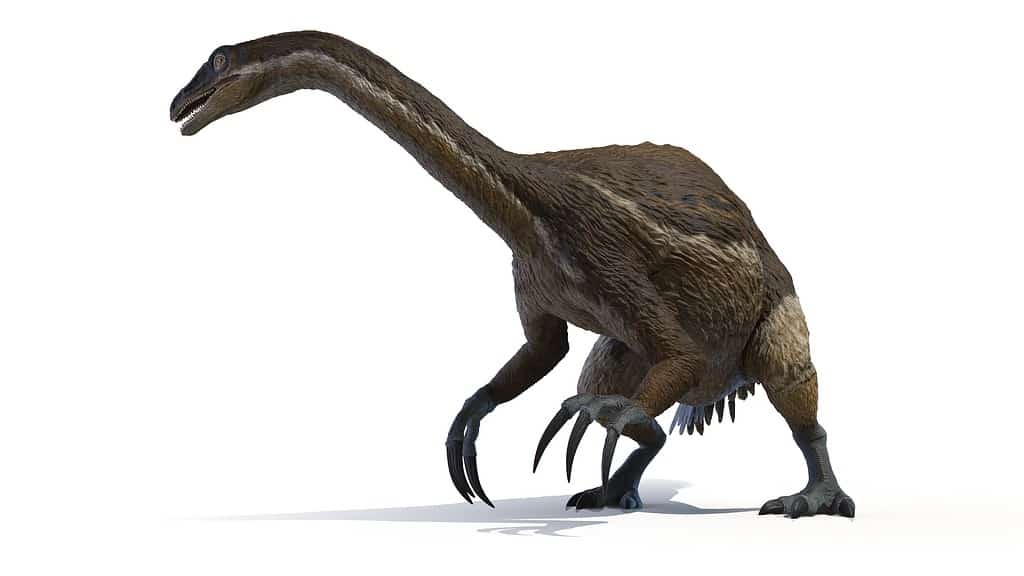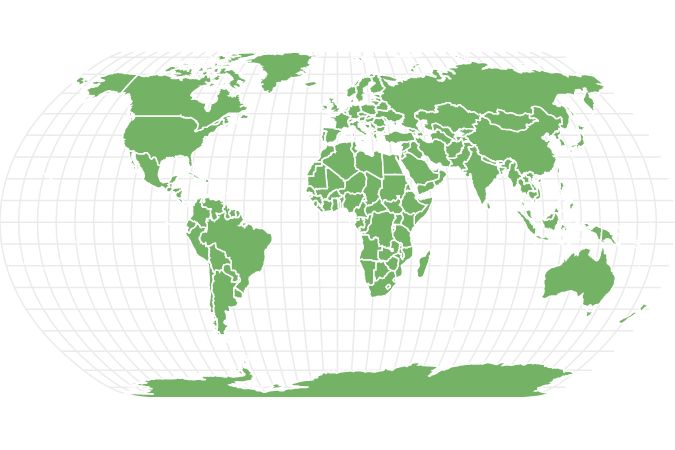Therizinosaurus
Therizinosaurus cheloniformis
Longest claws of any terrestrial animal in history
Advertisement
Therizinosaurus Scientific Classification
- Kingdom
- Animalia
- Phylum
- Chordata
- Order
- Dinosauria
- Family
- Therizinosauridae
- Genus
- Therizinosaurus
- Scientific Name
- Therizinosaurus cheloniformis
Read our Complete Guide to Classification of Animals.
Therizinosaurus Conservation Status
Therizinosaurus Facts
- Group Behavior
- Family units
- Fun Fact
- Longest claws of any terrestrial animal in history
- Biggest Threat
- Large carnivores
- Most Distinctive Feature
- Long claws
- Distinctive Feature
- Long neck
- Habitat
- Riparian areas and forests
- Diet
- Herbivore
- Favorite Food
- Leaves and twigs
- Special Features
- Claws almost three feet long
- Number Of Species
- 1
- Location
- Mongolia
View all of the Therizinosaurus images!
Therizinosaurus is a genus of large, herbivorous dinosaurs from the Late Cretaceous period. The genus contains a single species, Therizinosaurus cheloniformis. Like all therizinosaurids, Therizinosaurus featured huge claw bones that were likely used to grasp and pull vegetation or as a form of defense. While originally thought to be related to ancient turtles, most experts now consider them close relatives to birds.
Description & Size

Therizinosaurus’s claws are believed to have been over 3 feet in length.
©SciePro/Shutterstock.com
Therizinosaurus ranks as the largest therizinosaur dinosaur ever discovered. On average, Therizinosaurus measured 30 to 33 feet long and stood between 13 and 16 feet high. In terms of weight, they weighed anywhere from 3 to 5 tons, or 6,600 and 11,000 pounds.
Like other therizinosaurids, Therizinosaurus had a relatively small skull in proportion to the rest of its body. It possessed a long neck and a large, robust body. According to most experts, its body was likely sparsely covered in feathers. The neck came forward while the pelvis had a backward orientation, lending it an active, forward-leaning posture. Based on estimates, the hind legs measured around 9.8 feet long, while the neck measured close to 7.2 feet long.
Among Therizinosaurus’s most distinguishing features were the three gigantic claws it had on each forelimb. While common among therizinosaurs, the long claws of Therizinosaurus measured nearly 20 inches long. This means Therizinosaurus sported the longest claws of any known terrestrial animal. However, unlike other therizinosaurs, its claws appeared extremely straight and flat, only curving sharply right before the tip.
Evolution and History
Therizinosaurus belongs to the clade Theropoda, whose members go by the collective name theropods. All theropods share common features, including hollow bones and three large claws on the feet and hands. The first therapods emerged around 230 million years ago in the Late Triassic period. While mostly carnivorous, some species adopted an omnivorous or even herbivorous lifestyle. During the Jurassic period, the first birds evolved from specialized theropods. These birds are the ancient ancestors of the nearly 10,000 bird species alive today.
At the time of its discovery, paleontologists thought Therizinosaurus likely evolved from ancient marine turtles. However, additional discoveries of related species led to a change in thought about the evolution of Therizinosaurus. Some experts thought it might share ties with the herbivorous sauropods or the bird-like dinosaurs of Ornithischia that emerged during the Late Cretaceous period. Today, most experts classify Therizinosaurus as maniraptorans in the clade Theropoda. Some of its possible, distant relatives may include Neimongosaurus and Suzhousaurus, theropods that lived during the Early Cretaceous and shared a similar range to Therizinosaurus.
Diet – What Did Therizinosaurus Eat?
Contrary to what saw in the film Jurassic World: Dominion, Therizinosaurus did not eat meat. In fact, Therizinosaurus was a herbivore that almost exclusively ate plant material. Experts believe it was a browser with a diet mostly consisting of twigs and leaves. It probably used its long claws to grasp at branches and leaves overhead. That said, it also may have eaten fruits, seeds, or nuts. For example, it could use its long claws to pierce fruit hanging from trees or to dig up roots or tubers buried underground. One theory suggests that Therizinosaurus used its claws to dig through termite mounds. However, the relative fragility of the claws makes this theory unlikely at best.
Habitat – When and Where it Lived
Therizinosaurus lived in Asia during the Late Cretaceous period between 72 and 66 million years ago. This period is known as the Maastrichtian age and represents the last stage of the Late Cretaceous period. Discovered fossils originated in the Nemegt Formation, a geological formation in the Gobi Desert in Mongolia.
Examination of the Nemegt Formation reveals that Therizinosaurus lived in woodlands and riparian areas. It thrived in enclosed canopy forests with plenty of foliage that it could eat. The climate was likely rather temperate, with cold, dry winters and hot, wet summers. In terms of present equivalents, the area may have resembled the swamplands of the Okavango Delta in modern-day Botswana.
Threats and Predators
Due to its enormous size, Therizinosaurus likely had few to no natural predators once it reached full maturity. Therizinosaurus ranks as one of the tallest dinosaurs of the Late Cretaceous period. As a result, few predators would willingly tangle with a fully grown, adult specimen. That said, an adult Tarbosaurus could pose a threat to a small or juvenile Therizinosaurus. This large, carnivorous tyrannosaurid dinosaur stood nearly 10 feet tall and weighed about the same as Therizinosaurus. Some paleontologists believe that Therizinosaurus might have used its long claws to ward off predators such as Tarbosaurus. However, the issue remains that its claws were likely too fragile to pose any real threat to a large predator.
Discoveries and Fossils – Where It was Found
Therizinosaurus fossils were first discovered in 1948. At that time, the USSR Academy of Sciences organized several expeditions to excavate the Nemegt Formation, a geological formation in the Gobi Desert in southwestern Mongolia. During these expeditions, paleontologists uncovered the fossils of numerous reptiles and dinosaurs. However, the fossils remained undescribed for nearly 6 years until the Russian paleontologist Evgeny Maleev examined the remains in 1954.
The most noteworthy fossils in the collection included several large claw bones belonging to Therizinosaurus. Maleev chose the name Therizinosaurus, which derives from the Greek words therizo, meaning “scythe,” and sauros, meaning “lizard,” in honor of these large claws. Meanwhile, the specific name cheloniformis stems from the Greek word cheloni, meaning “turtle,” and the Latin formis meaning “shape of.” Maleev believed Therizinosaurus to be a form of marine turtle, but this view was refuted in 1970 when Russian paleontologist Anatoly Rozhdestvensky suggested it was a theropod. The skeleton of the most-complete Therizinosaurus is now on display at the Museum of Northern Arizona.
Extinction – When Did It Die Out?
Compared to most therizinosaurs, Therizinosaurus lived for a relatively short period of time, at least according to existing fossil records. The earliest fossils date back to around 72 million years ago but disappear completely around 66 million years ago. At that time, a giant extinction event occurred that wiped out nearly 75% of all life on Earth. Known as the Cretaceous-Paleogene extinction event, this event was likely caused when a massive asteroid crashed into the Yucatan Peninsula in the Gulf of Mexico. The impact spewed tremendous amounts of particulates into the air. This debris affected the global climate and led to a lingering winter that killed off plant life and plankton around the world. This initiated a massive domino effect that killed off the majority of life on Earth, including Therizinosaurus.
Similar Animals to Therizinosaurus
- Erliansaurus. Erliansaurus was a therizinosaur dinosaur that lived in Asia during the Late Cretaceous period around 96 million years ago. It measured around 8.5 to 13.1 feet long and weighed between 201 and 882 pounds.
- Neimongosaurus. Another therizinosaur dinosaur of the Late Cretaceous, Neimongosaurus lived in Asia around 96 million years ago. This small bipedal herbivore measured from 7.5 to 9.8 feet long and weighed from 201 to 500 pounds.
- Suzhousaurus. Suzhousaurus lived between 124 and 113 million years ago in the Early Cretaceous period. One of the largest therizinosaurids of its team, Suzhousaurus measured around 20 feet long and weighed nearly 6,800 pounds.
FAQ
When did Therizinosaurus live?
Therizinosaurus emerged near the end of the Late Cretaceous period, around 72 million years ago. It died out approximately 66 million years during the Cretaceous-Paleogene extinction event, likely caused by a massive asteroid crashing into the Earth.
How big was Therizinosaurus?
Therizinosaurus ranks as one of the largest therizinosaurs to ever live. It measured up to 33 feet long, 16 feet tall, and nearly 11,000 pounds.
View all 133 animals that start with TTherizinosaurus FAQs (Frequently Asked Questions)
When did Therizinosaurus live?
Therizinosaurus emerged near the end of the Late Cretaceous period around 72 million years ago. It died out approximately 66 million years during the Cretaceous-Paleogene extinction event, which was likely caused when a massive asteroid crashed into the Earth.
How big was Therizinosaurus?
Therizinosaurus ranks as one of the largest therizinosaurs to ever live. It measured up to 33 feet long, 16 feet tall, and nearly 11,000 pounds.
Thank you for reading! Have some feedback for us? Contact the AZ Animals editorial team.
Sources
- National Geographic, Available here: https://www.nationalgeographic.com/adventure/article/151226-animals-dinosaurs-claws-ancient-science-paleontology
- LiveScience, Available here: https://www.livescience.com/jurassic-worlds-bizarre-scythe-clawed-dinosaur-couldnt-have-been-a-slasher-study-confirms
- ScienceTime, Available here: https://www.sciencetimes.com/articles/38154/20220610/meet-therizinosaurus-k-scythe-lizard-herbivorous-dinosaur-kill-t-rex.htm

















